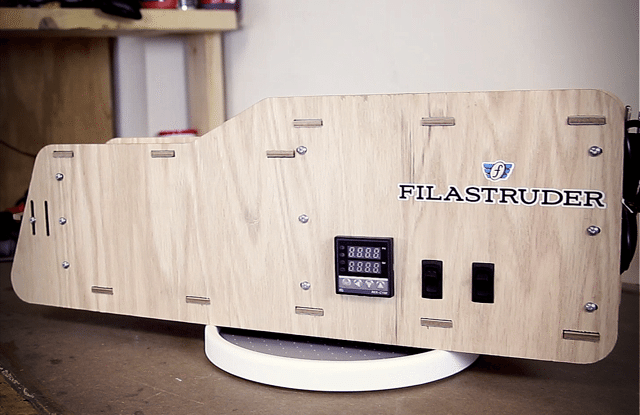
Filastruder combines money-saving logic with easy usability for a product that could help boost the 3D printing industry.
By Caitlyn Finnegan
It’s a classic story in the world of startups: A guy has an idea for a better way of doing things. Guy gets to work raising funds for the idea. Guy raises nearly $200,000 in two weeks.
Not so typical? Neither is the idea.
When mechanical engineering PhD student Tim Elmore launched a Kickstarter campaign for his filament extruder, Filastruder, on March 25, he never expected his idea for a cheaper way to produce 3D printing materials would become one of the hottest campaigns on the popular crowdfunding website. Now the project is drawing backers from all over the world and still steadily raising funds until the fundraising campaign ends April 24.
From Necessity, An Idea
The growing use of 3D printers, devices that turn digital blueprints into physical objects that have been used to make everything from plastic toys to skull implants, has placed a demand on developing simpler and cheaper ways to take part in the trend.
The average price for a single spool of plastic filament can cost a 3D-printing hobbyist anywhere from $30 to $50 – a price Elmore, still a graduate student at the University of Florida, wasn’t willing to pay when he started tinkering with 3D printers last fall.
“I realized that plastic is really cheap and that I shouldn’t be paying this much for it,” Elmore said.
He tried different personal filament extruders he found on the market, such as Filabot, but wasn’t content with their operating style. That’s when he decided to draw up plans, gather his tools and make one for himself.
Elmore designed his extruder to take plastic pellets, funnel them into the machine, heat them up and extrude a fine, plastic filament to use for 3D creations – a production process that lowers the cost of filament by more than 60 percent. He built his first working model in just a few weeks, and set up a partnership with OpenSource Printing, a small company based in New Hampshire, to supply the plastic pellets needed for the extruder and help pre-assemble testing kits.
Filastruder, a play on the words filament and extruder, was born. Elmore brought on Allen Haynes – a longtime friend and fellow UF graduate – to help market the product. Soon, the duo were spending their Saturdays in Elmore’s garage assembling kits and pellet packets.
After working through early glitches and design plans, the pair sent out 16 beta kits to willing testers in countries all over the world.
“We wanted to make sure we included the whole gamut; from people who were a beginner to 3D printers and others who already had experience with them,” Haynes said.
Rocketing to Success
After receiving positive feedback from the beta testers, Elmore and Haynes decided it was time to raise money to fund Filastruder’s growing manufacturing process.
They filmed a promotional video with the help of another friend, Ben Wade, and broke down their plan for the product.
“We wanted to under promise but over deliver when it came time to launch,” Elmore said.
Elmore chose Kickstarter for the fundraising platform because he had already backed other projects on the site and had an account. He and Haynes decided to place their goal amount at $5,000, with varying donation levels that rewarded donors with gifts ranging from a 3D-printed keychain to a fully assembled Filastruder kit.
What happened next changed everything: the campaign hit its goal of $5,000 in 61 minutes, going on to triple its goal by the end of its first day on the crowdfunding website.
What started as a quick project had turned into a business literally overnight, bringing in donations and attention from hundreds of supporters. After four days on the site, the campaign had raised $75,000 from a variety of backers, hitting maximum limits on its reward levels and causing Elmore and Haynes to quickly add more options for donations.
“It’s a crazy world we live in,” Elmore said. “I had just come up with the idea in December, and now four months later I have 1000 people backing me. Crowdfunding has done so much to help businesses get off the ground faster.”
As of April 16, the campaign had secured $192,186 from 793 backers. The campaign was chosen as a Kickstarter staff pick and was recognized as one of the site’s top three campaigns. Kickstarter staff even Skyped with the duo to discuss their project and make sure everything was going smoothly in light of the rapid response from backers.
“We may not have expected such a huge response, but we definitely are prepared for it,” Elmore said.
To License, or Not to License
For now, the team is racing to compile enough kits to meet the demands of donors while still working from their homebase in Elmore’s garage.
“Before the campaign, we just needed like 50 of everything,” Elmore said. “Now we need like 700 of everything. The biggest challenge has been locking down that supply chain and making sure we have backup suppliers to meet demands.”
Elmore said each kit takes an average of 12 minutes to assemble and comes with everything a hobbyist needs to build a personal filament extruder. The idea has attracted both local and national attention from interested hackerspaces and venture capitalists looking to invest.
The idea was never meant to spin into a huge company, Elmore said. Rather than building the business himself, he is considering licensing out the technology to another company.
“Before Kickstarter, this was just a hobby that involved hanging out on Saturdays to assemble kits,” Elmore said. “Now it has grown into something I’m not sure if I want to handle.”
The campaign still has seven days left, and both Elmore and Haynes recommend other aspiring entrepreneurs and inventors to turn to Kickstarter for funding.
“If you have an idea that you think can better a product or an environment for users, you should give it a shot,” Haynes said.




